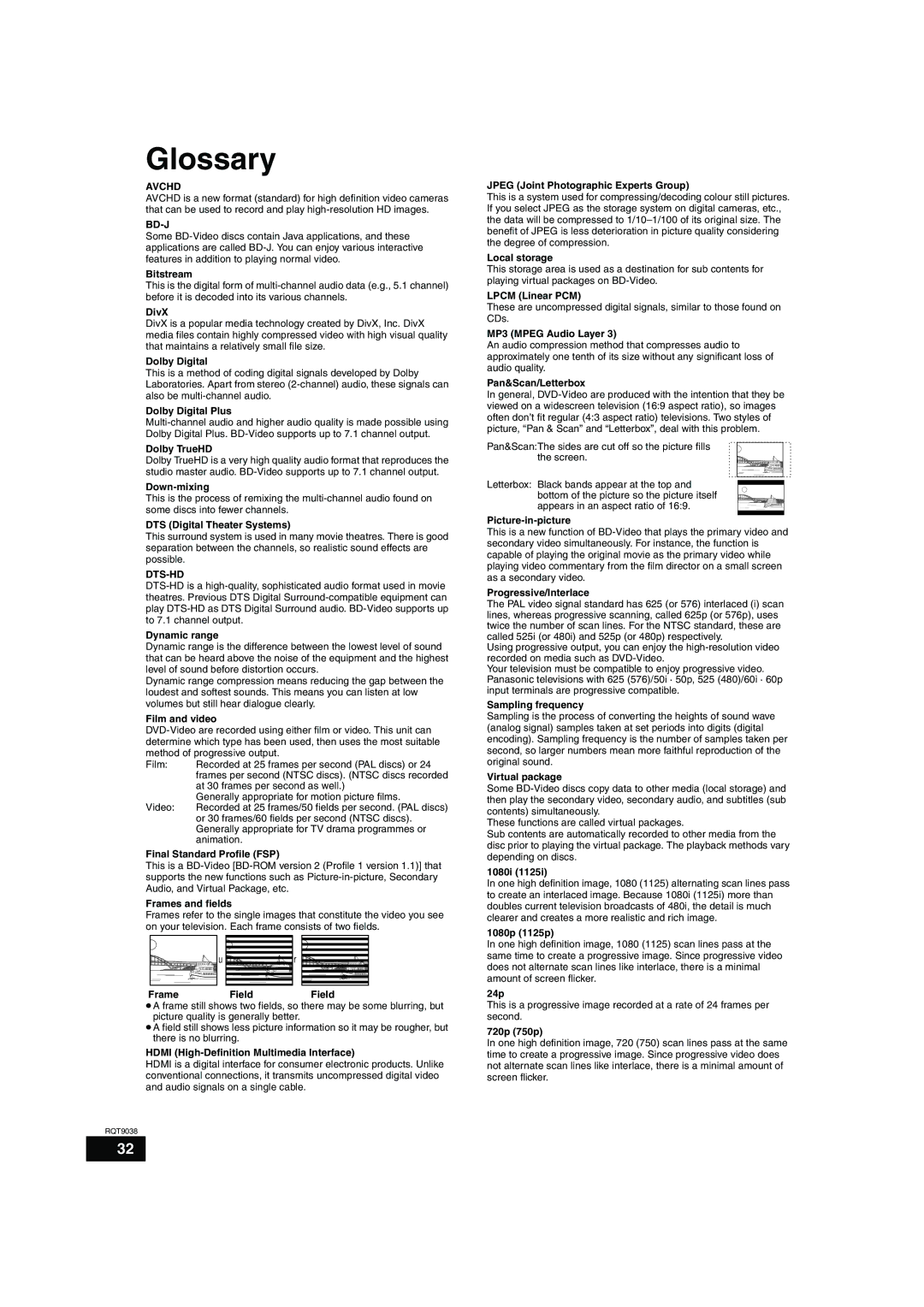
Glossary
AVCHD
AVCHD is a new format (standard) for high definition video cameras that can be used to record and play
BD-J
Some
Bitstream
This is the digital form of
DivX
DivX is a popular media technology created by DivX, Inc. DivX media files contain highly compressed video with high visual quality that maintains a relatively small file size.
Dolby Digital
This is a method of coding digital signals developed by Dolby Laboratories. Apart from stereo
Dolby Digital Plus
Dolby TrueHD
Dolby TrueHD is a very high quality audio format that reproduces the studio master audio.
Down-mixing
This is the process of remixing the
DTS (Digital Theater Systems)
This surround system is used in many movie theatres. There is good separation between the channels, so realistic sound effects are possible.
DTS-HD
Dynamic range
Dynamic range is the difference between the lowest level of sound that can be heard above the noise of the equipment and the highest level of sound before distortion occurs.
Dynamic range compression means reducing the gap between the loudest and softest sounds. This means you can listen at low volumes but still hear dialogue clearly.
Film and video
Film: | Recorded at 25 frames per second (PAL discs) or 24 |
| frames per second (NTSC discs). (NTSC discs recorded |
| at 30 frames per second as well.) |
| Generally appropriate for motion picture films. |
Video: | Recorded at 25 frames/50 fields per second. (PAL discs) |
| or 30 frames/60 fields per second (NTSC discs). |
| Generally appropriate for TV drama programmes or |
| animation. |
Final Standard Profile (FSP)
This is a
Frames and fields
Frames refer to the single images that constitute the video you see on your television. Each frame consists of two fields.
u | r |
Frame FieldField
≥A frame still shows two fields, so there may be some blurring, but picture quality is generally better.
≥A field still shows less picture information so it may be rougher, but there is no blurring.
HDMI (High-Definition Multimedia Interface)
HDMI is a digital interface for consumer electronic products. Unlike conventional connections, it transmits uncompressed digital video and audio signals on a single cable.
RQT9038
JPEG (Joint Photographic Experts Group)
This is a system used for compressing/decoding colour still pictures. If you select JPEG as the storage system on digital cameras, etc., the data will be compressed to
Local storage
This storage area is used as a destination for sub contents for playing virtual packages on
LPCM (Linear PCM)
These are uncompressed digital signals, similar to those found on CDs.
MP3 (MPEG Audio Layer 3)
An audio compression method that compresses audio to approximately one tenth of its size without any significant loss of audio quality.
Pan&Scan/Letterbox
In general,
Pan&Scan:The sides are cut off so the picture fills the screen.
Letterbox: Black bands appear at the top and bottom of the picture so the picture itself appears in an aspect ratio of 16:9.
Picture-in-picture
This is a new function of
Progressive/Interlace
The PAL video signal standard has 625 (or 576) interlaced (i) scan lines, whereas progressive scanning, called 625p (or 576p), uses twice the number of scan lines. For the NTSC standard, these are called 525i (or 480i) and 525p (or 480p) respectively.
Using progressive output, you can enjoy the
Your television must be compatible to enjoy progressive video. Panasonic televisions with 625 (576)/50i · 50p, 525 (480)/60i · 60p input terminals are progressive compatible.
Sampling frequency
Sampling is the process of converting the heights of sound wave (analog signal) samples taken at set periods into digits (digital encoding). Sampling frequency is the number of samples taken per second, so larger numbers mean more faithful reproduction of the original sound.
Virtual package
Some
These functions are called virtual packages.
Sub contents are automatically recorded to other media from the disc prior to playing the virtual package. The playback methods vary depending on discs.
1080i (1125i)
In one high definition image, 1080 (1125) alternating scan lines pass to create an interlaced image. Because 1080i (1125i) more than doubles current television broadcasts of 480i, the detail is much clearer and creates a more realistic and rich image.
1080p (1125p)
In one high definition image, 1080 (1125) scan lines pass at the same time to create a progressive image. Since progressive video does not alternate scan lines like interlace, there is a minimal amount of screen flicker.
24p
This is a progressive image recorded at a rate of 24 frames per second.
720p (750p)
In one high definition image, 720 (750) scan lines pass at the same time to create a progressive image. Since progressive video does not alternate scan lines like interlace, there is a minimal amount of screen flicker.
32
